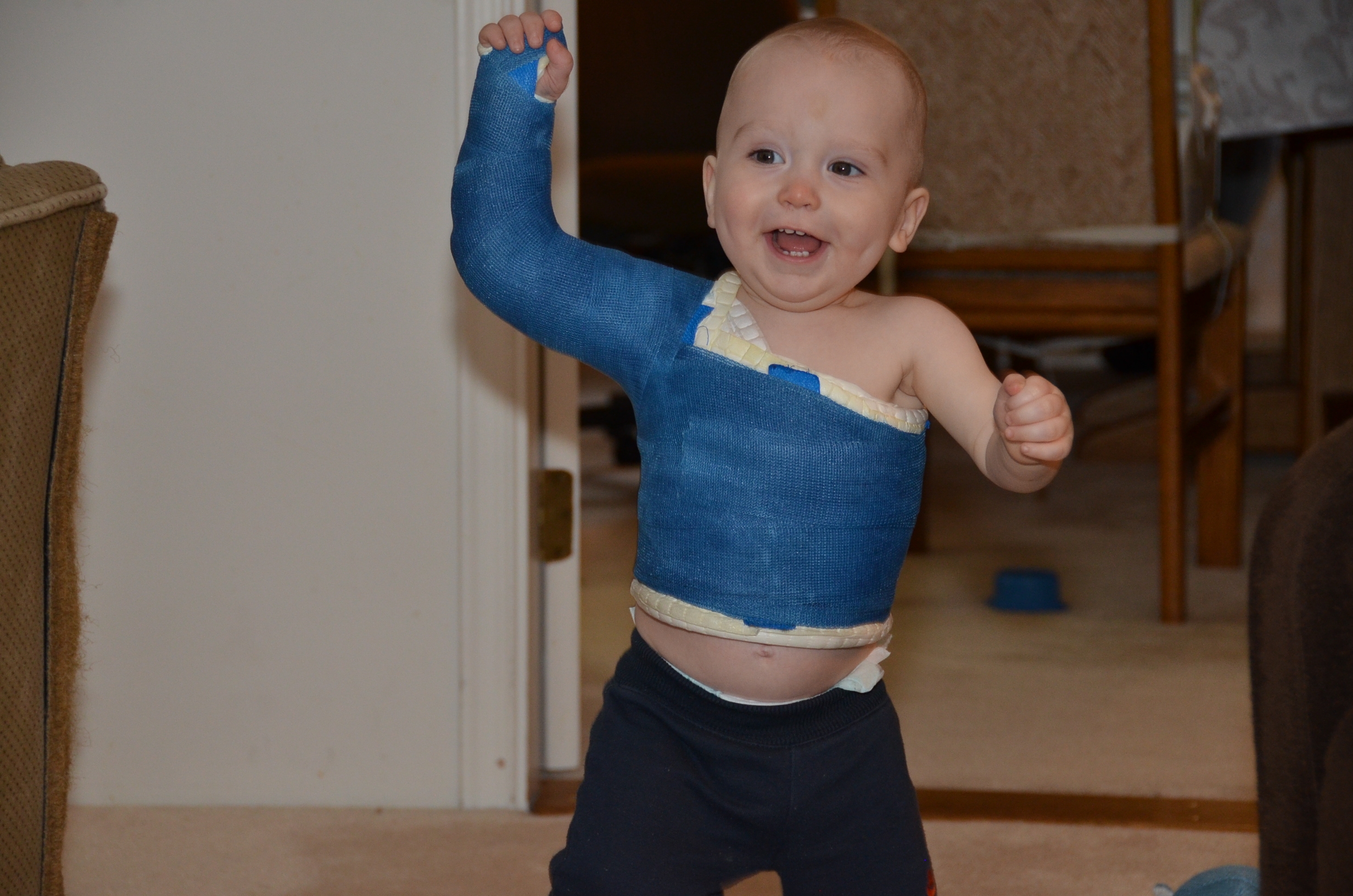Splint
- How do I know how much a splint should be worn?
-
Your treatment team will guide you in the recommended splint wear schedule, which will depend your child’s individual abilities and stage of treatment, such as age, active arm movements, ease of stretching exercises at specific joints, and developmental progress.
- Will this injury and/or splinting affect my child’s development?
-
Developmental progress is individual for each child. In general, children with an isolated brachial plexus injury do not experience a delay in their gross motor development skills. However, we encourage such skills as crawling and weight bearing on the arms for as long as possible, as this supports strengthening of the arm joints.
Prolonged splinting or a period of casting, throughout most of the day, may be necessary to maximize the recovery of your child’s shoulder positioning. While any immobilization protocol may result in a temporary delay in achieving gross motor milestones, such as independent sitting and crawling, we have found these children catch up to their peers very quickly once the cast or splint is tapered from the daytime hours – typically by 10 to 12 months of age.
- Do I need to get special clothing to accommodate a splint?
-
No specialized clothing is required to accommodate the splint, but parents have offered the following modification recommendations:
- Cut off the sleeve of the involved side
- Cut slits in the sleeve for the Velcro straps to come through
- Wear larger size clothing
- How do I get my child in a car seat with a splint on?
-
No modifications are required. Not having the ER straps on in the car seat is part of the wear schedule.
- How do children tolerate wearing a splint?
-
We find children tolerate the splinting very well, especially when started at an early age. Successful parents tell us that establishing a routine and discipline around use of the splint is key and becomes as natural as brushing your teeth.
Cast
- Do I need to get special clothing to accommodate a cast?
-
- Your child will likely need larger size clothing to fit over the cast. We estimate that the cast takes up approximately and extra six inches all the way around. Clothing that secures at the front is also easier to get off and on.
- Some parents have split the sleeve on the involved side and secured closed with Velcro tabs to make clothing easier to get off and on.
- How do I get my child in a car seat with a cast on?
-
You may require a bigger car seat or stroller depending on the age of your child and design of your car seat/stroller (for example, if you have a car seat with high sides). Please review the sample image below of the cast position and consider whether you will need a larger car seat.

- How do I look after the cast?
-
- Ensure that nothing is stuck down inside the cast.
- Monitor cast edges for any signs of skin rubbing which can result with active movement. Let your doctor know if this occurs and in what location, and they will guide you as to what to do.
- Ask your doctor if you can bath your child with the cast on. This will depend on the type of under-padding used in the cast.
- Unless instructed otherwise, keep the cast dry at all times – this means sponge baths.
- It’s a good idea to gently clean around the edges of the splint (i.e. hand and torso) with a damp cloth, on a daily basis. Make sure to dry well afterwards.
- Keep your child cool as best possible.
- Monitor the color of the finger tips a few times a day. While children typically experience no problems with the cast, as a child grows the fit of the cast may become snug – white or dark purple finger tips may indicate that the cast needs to come off – see your doctor.
- Try to pick up and support your child from the hips, NOT from the bottom of the cast, or arm. Frequent tugging at the cast may cause it to shift positions and change the fit.
- How might my child respond to the cast?
-
- Your child should not be in any pain following the botox injection and cast application. However, they may be frustrated with their arm being ‘stuck’ in a certain position. Each child’s response is different, but for the most part, children adjust very well.
- By maintaining a calm and reassuring approach with your child you can help them to adjust. Offer lots of different activities like books, games and music to help pass the time.
- If you are concerned that your child is uncomfortable after the procedure, you can give them a bit of children’s Advil or Tylenol.
- Your child will resume their normal daily activities over a period of 1 to 2 days as they get used to their new positioning and weight.
- How will the cast be removed?
-
The cast is removed by cutting it with an oscillating saw, which does not spin, but vibrates rapidly
back and forth. The cast saw does make a lot of noise, so can be scary for children, but it is not painful. It is very important to tell your cast technician if your child has picked out some of the padding, or placed anything inside the cast. - What happens after the cast is removed?
-
- Your child’s arm movements will be a little stiff and over-corrected at first, but this will gradually improve with time out of the cast.
- We encourage you to gently re-initiate your range of motion (stretching) exercises, the day following cast removal.
- Positioning post cast removal is highly dependent on your child’s individualized treatment plan. However, it is very likely that your child will continue with some kind of splint. They may be able to fit into a pre-existing splint, or may require a new splint which can take up to 2 hours to make and fit, following the cast removal.
- Positional splinting will continue for several months post the cast removal.
